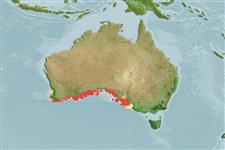>
Syngnathiformes (Pipefishes and seahorses) >
Syngnathidae (Pipefishes and seahorses) > Syngnathinae
Etymology: Phycodurus: Greek, phykon = seaweed + Greek, dora = skin (Ref. 45335).
More on author: Günther.
Environment: milieu / climate zone / depth range / distribution range
বাস্তুসংস্থান
সামুদ্রিক রীফ সংশ্লিষ্ট; অ_ পরিযায়ী; গভীরতার পরিসীমা 4 - 30 m (Ref. 9002). Temperate; 32°S - 39°S, 115°E - 140°E (Ref. 57011)
Eastern Indian Ocean: endemic to southern Australia.
Length at first maturity / আকৃতি / ওজন / Age
Maturity: Lm ?, range 20 - ? cm
Max length : 35.0 cm TL পুরুষ/ লিঙ্গ অনিধর্ারিত ; (Ref. 9002)
Usually occur over sand patches close to reefs with kelp, feeding on mysids and other crustaceans. Ovoviviparous (Ref. 205). The male carries the eggs in a brood pouch which is found under the tail (Ref. 205). One of the most spectacular examples of camouflage: neither prey nor predators recognize it as a fish.
About 250 eggs are incubated by males on the underside of the tail, where they are embedded in spongy tissue (Ref. 31838).
Kuiter, R.H., 1993. Coastal fishes of south-eastern Australia. University of Hawaii Press. Honolulu, Hawaii. 437 p. (Ref. 9002)
IUCN Red List Status (Ref. 130435)
Threat to humans
Harmless
Human uses
মৎস্য: আকর্ষণবিহীণ ; মৎস্যাধার / এ্যাকুয়ারিয়াম : বাণিজ্যিক
আরো তথ্য
সূত্র সংখ্যা এ্যাকুয়াকালচার (জলজ পালন) এ্যাকুয়াকালচার নকশা বংশ বংশানুগতিবিদ্যাElectrophoresesউতরাধিকার সুত্রে পাওয়া যোগ্যতারোগ প্রক্রিয়াজাতকরণ NutrientsMass conversion
হাতিয়ার
Special reports
Download XML
ইন্টারনেট সুত্র
Estimates based on models
Preferred temperature (Ref.
123201): 16.3 - 18.5, mean 17.8 °C (based on 104 cells).
Phylogenetic diversity index (Ref.
82804): PD
50 = 1.0000 [Uniqueness, from 0.5 = low to 2.0 = high].
Bayesian length-weight: a=0.00447 (0.00177 - 0.01127), b=3.00 (2.78 - 3.22), in cm total length, based on LWR estimates for this (Sub)family-body shape (Ref.
93245).
ট্রফিক পর্যায়ে (Ref.
69278): 3.3 ±0.45 se; based on food items.
স্থিতিস্থাপক (Ref.
120179): উচ্চ, সর্বনিম্ন প্রজন দ্বিগুনের সময় ১৫ মাস (Preliminary K or Fecundity.).
Fishing Vulnerability (Ref.
59153): Low vulnerability (25 of 100).
Nutrients (Ref.
124155): Calcium = 22.8 [9.5, 42.9] mg/100g; Iron = 0.23 [0.12, 0.42] mg/100g; Protein = 18.3 [17.1, 19.6] %; Omega3 = 0.269 [0.137, 0.505] g/100g; Selenium = 7.82 [3.39, 18.95] μg/100g; VitaminA = 42.6 [10.2, 182.7] μg/100g; Zinc = 0.623 [0.397, 0.991] mg/100g (wet weight);
